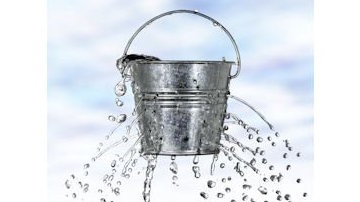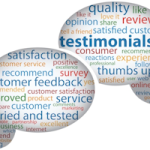- Want to learn more?
- [email protected]
My Bucket List for CX Leaders: 10 Best Practices for Higher Retention

Beyond the Obvious Lead Growth for $1Bn Health Network
March 17, 2015
25% Savings Uncovered in Fortune 50 Revenue Project
March 31, 2015My Bucket List for CX Leaders: 10 Best Practices for Higher Retention

There’s a hole in the bucket, dear Liza, dear Liza.
There’s a hole in the bucket, dear Liza, a hole.
I remember singing that old German song as a child. Well, I’m singing it again as a customer experience expert, and this time, it’s about business: the bucket is your company, and your customers are slipping away through the holes.
Whether you’re a mid-sized company or a Fortune 200 enterprise, high customer retention is a survival priority in today’s business environment, and increasing retention is a core strategy for remaining competitive. Need proof? Recent statistics underscore the tremendous value of loyal customers:
- “80% of your future business will come from 20% of your current customers.” (Gartner)
- “The probability of selling to an existing customer is 60–70% while the probability of selling to a new prospect is 5–20%.” (Marketing Metrics)
Despite those realities, some company leaders assume that relationships with their existing customer base can coast along on autopilot after initial acquisition, without requiring ongoing investment on the company’s part; but that assumption is mistaken, and very costly.
If customers are not treated as your company’s most valuable asset—with the utmost attention paid to providing customer experience excellence and helping customers to realize maximum product value—they will leave, taking your predictable revenue and profits with them. In my view, that’s a compelling argument for a sound customer retention strategy.
(Note to SaaS companies: Given a churn-vulnerable business model of services offered monthly, often without a contract, plus mounting pressure from Wall Street to increase retention and accurately predict revenue, I urge you to take advantage of the following strategies.)
As a business consultant, I focus on key steps to maximize true value for both customer and company. I want to help company leaders succeed in their customer retention efforts by sharing the approaches I’ve learned and created over my 25 years of professional experience. Here are my top 10 best practices that will mend the customer retention holes in your leaky bucket!
1. Exceptional Service for Current Customers. In a highly competitive, constantly changing marketplace with ever-rising customer expectations, I cannot overemphasize the importance of outstanding service to existing customers. Exceptional service—relationship-driven, value-focused, free of dis-satisfiers that drive churn—is the indisputable foundation of customer retention and a critical starting point in formulating your company’s retention strategy.
 2. Voice-of-the-Customer Program. Understanding what your customers think is essential to high retention. VoC research can inform all aspects of engagement as well as actions to improve the service experience and increase realized product value, but I see many companies using oversimplified methodology (hint: one question is not enough). Strategically designed surveys yield valuable insights into what really matters—especially unmet needs or weaknesses causing dissatisfaction and deflection.
2. Voice-of-the-Customer Program. Understanding what your customers think is essential to high retention. VoC research can inform all aspects of engagement as well as actions to improve the service experience and increase realized product value, but I see many companies using oversimplified methodology (hint: one question is not enough). Strategically designed surveys yield valuable insights into what really matters—especially unmet needs or weaknesses causing dissatisfaction and deflection.
3. Customer Journey Mapping. You need to know, from the inside out, how customers flow through your organization: is that flow logical, simple, and streamlined, and does it produce a high-quality, consistent, repeatable experience? Journey mapping identifies challenges that customers encounter, plus opportunities to make changes that create value and deepen engagement while trimming cost.
4. Customer Segmentation. I find that segmentation is powerful when tied to overall company goals and focused on increased value for customers. Categorizing customers into market or service groups points you toward winning and retaining “the right customers.” Customizing your service delivery to different segments also helps to utilize limited resources wisely.
5. Proactive Customer Service. Reacting to customer service requests is a performance baseline—but forecasting and responding to customer expectations proactively is an entirely different endeavor. For example, are you conducting site visits with your most valued customers to learn their needs, help them to realize product value, and gather insights for new product features? I highly recommend this type of anticipatory service approach.
6. Engagement and Retention Marketing. Proactive outreach is an uncommon but very promising approach for creating customer value and profit potential while preserving existing revenues. Interactions that educate current customers, stimulate use of your product, and resolve issues also foster an invaluable emotional connection. If conducted in a manner that respects your customers’ time and privacy, this type of marketing is a service experience differentiator, building the relationships that lead to loyalty.
7. Assistive Technology. The SaaS/Cloud technology roster used to support customer loyalty is changing everything. I advocate using customer health dashboards and social media scanners as well as other enabling technologies in the areas of VoC and customer intelligence, application adoption monitoring, and engagement and retention marketing. By purposely facilitating ongoing customer relationships post-sale, these tools provide a powerful competitive advantage.
8. Loyalty Rewards. Customers review where their money is spent and consolidate their purchasing under loyalty programs featuring rewards that they actually want. What are your loyalty program’s objectives, strategies, positioning, and value? For maximum appeal, offer customer-relevant reward options and a quick, easy redemption process.
9. Customer Win-Back. Did some customers leave? Don’t let it end there. Reach out to understand what happened; tell them about the changes you’ve made to resolve the issues that led to their departure; share your exciting roadmaps and future vision; entice them to come back with a loyalty offer they’ll value—and then keep them with excellence.
10. Employee Engagement. Last but certainly not least, happy employees are a crucial prerequisite for happy customers: the relationship between employee engagement and customer engagement is undeniable. Therefore, it is vital to ensure that employees throughout your company are educated, encouraged, and empowered to promote and enact your customer retention strategy at all times.
Throughout my career, I’ve seen the discipline of customer experience emerge, expand, evolve, and now begin to prove its tremendous value—and that value, along with a clear supporting strategy, should not be underestimated. The ability to champion customer experience excellence company-wide is, quite simply, the lynchpin to retaining, expanding, and acquiring new revenue. The creation of a customer experience strategy—and its unwavering, flawless execution—is vital to achieving a sustainable edge over competitors.
Stay tuned over the coming weeks as I delve more deeply into these key elements. This eight-article series will give you valuable insights and guidance as you plan, develop, and implement your own customer experience strategy.
Ready to move forward more quickly? Interested in personal assistance? Let’s chat. Please sign up for my complimentary one-hour Customer Insight Strategy Session by calling our office at 617.848.4589 or emailing [email protected].
Lori Carr is a customer experience pioneer and expert. Working with Fortune 500 companies for the past 25 years, she helps recognized brands to dramatically increase retention, loyalty, and profitable revenues.



